There are five main routes that we all need to know about.
For information purposes, we have produced some maps using Flightradar24, but please note that they are indicative because aircraft may not follow the prescribed route, and also because Flightradar24, in the same manner as WebTrak used by BHAL, is not accurate.
Arrival Route to R21
The most in use (currently some 80% of all arrivals) is the one called ILS route to R21. ILS stands for Instrument Landing System and R21 (Runway 21) is the Northern end of the runway.

Departure Route from R21
This is the departure route from the Southern end of the runway. It loops away from Biggin Hill towards New Addington and then turns East over the airport. This is a Noise Preferential Routing. To avoid built-up areas, the loop should cross the runway, avoiding New Addington and Shire Lane, but there are frequent infractions, taking this route as far North as Keston and the Crofton area. Constant infractions to this route constitute a breach of the Lease.

Arrival Route to R03
Runway 03 is the Southern end of the runway. This is in use when the wind blows from the North/North East, which is, supposedly, 30% of the time. Currently, the approach to R03 should follow the ILS Route until it has passed the PRUH hospital and then turn West in a loop before reverting up to Biggin Hill. However the new aircraft operating at the airport now turn over or even before the PRUH hospital, thus badly impacting the populated residential areas of Crofton, Locksbottom and Keston. It was a condition of approval of the longer operating hours that this route would be replaced by a new one, in order to relieve the areas at the North of the airport, which are already affected by the very busy ILS route. More than six years after the new hours were approved, this new route has now been rejected by the CAA. It has transpired from the CAA report and a document by BHAL’s own consultants that BHAL has known all along that this route would present material safety concerns but continued to mislead the Council as to its deliverability in order to be granted the extended hours. The absence of this major mitigation for the residents is a game changer. A barrister engaged by Flightpath Watch has declared that this is a major event, and that the Council is entitled to suspend the extended hours.

Departure Route from R03
This is the departure route to the North. A Noise Preferential Routing requires that pilots turn East 1 nautical mile from take-off, so as to avoid the built-up areas at the North of the airport. This is constantly breached and departures reach the PRUH hospital and beyond before pilots turn East. As with Departure Route from R21, consistently missing the turn is an event of default under the lease but the Council has so far refused to enforce Noise Preferential Routings.

Circuits
Circuit training is allowed at Biggin Hill and a map has been devised to avoid residential areas (look in particular at Plan B in the image below, which was taken from BHAL’s website, before it was suddenly removed). Lack of respect of this route is an event of default under the lease. BHAL largely disregards it and the Council refuses to enforce it. With the advent of larger planes for pilots to train on, and the establishment of Bombardier’s maintenance facilities at Biggin Hill, circuits for training or, worse, engine testing by Bombardier, have become a real issue, as they now affect densely populated areas from Keston, to Crofton to even Petts Wood. Circuits are disruptive and dangerous, and the existing map needs to be enforced by the Council.

Noise-Sensitive Areas
In addition to the above noise abatement routes, there are seven noise-sensitive areas (NSAs), that should be avoided by light aircraft and helicopters. With Castle Air now increasing their heli-facilities at Biggin Hill Airport by 23 additional helicopters, monitoring avoidance of these areas is very important.

,
